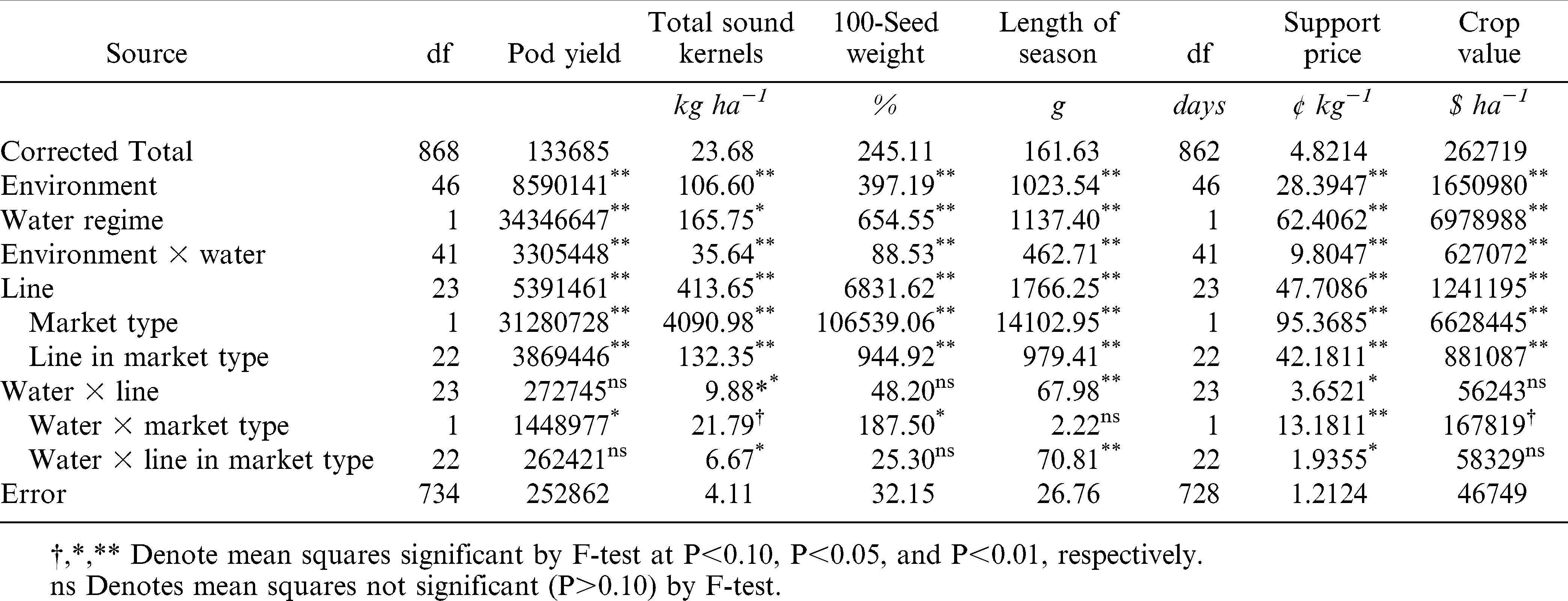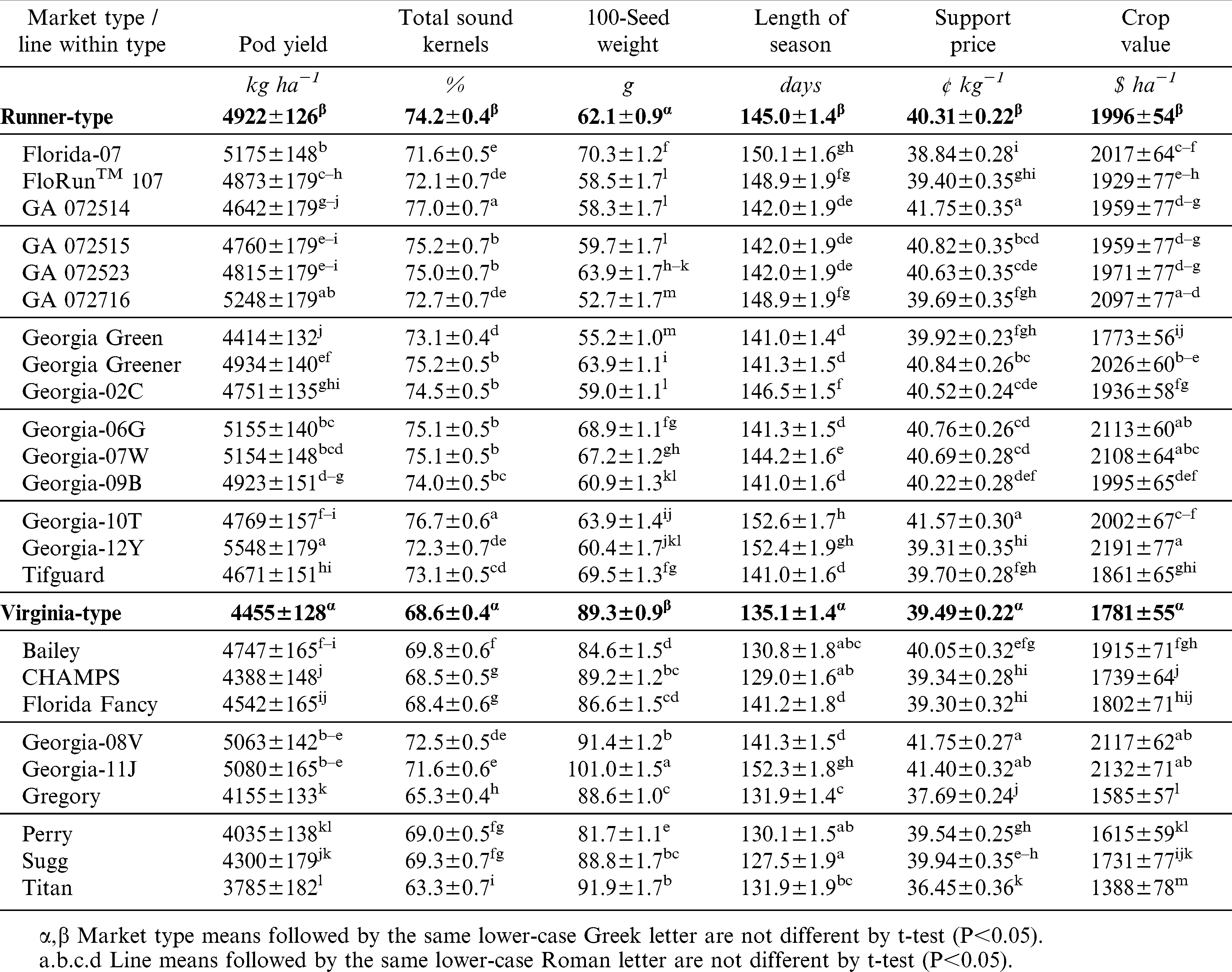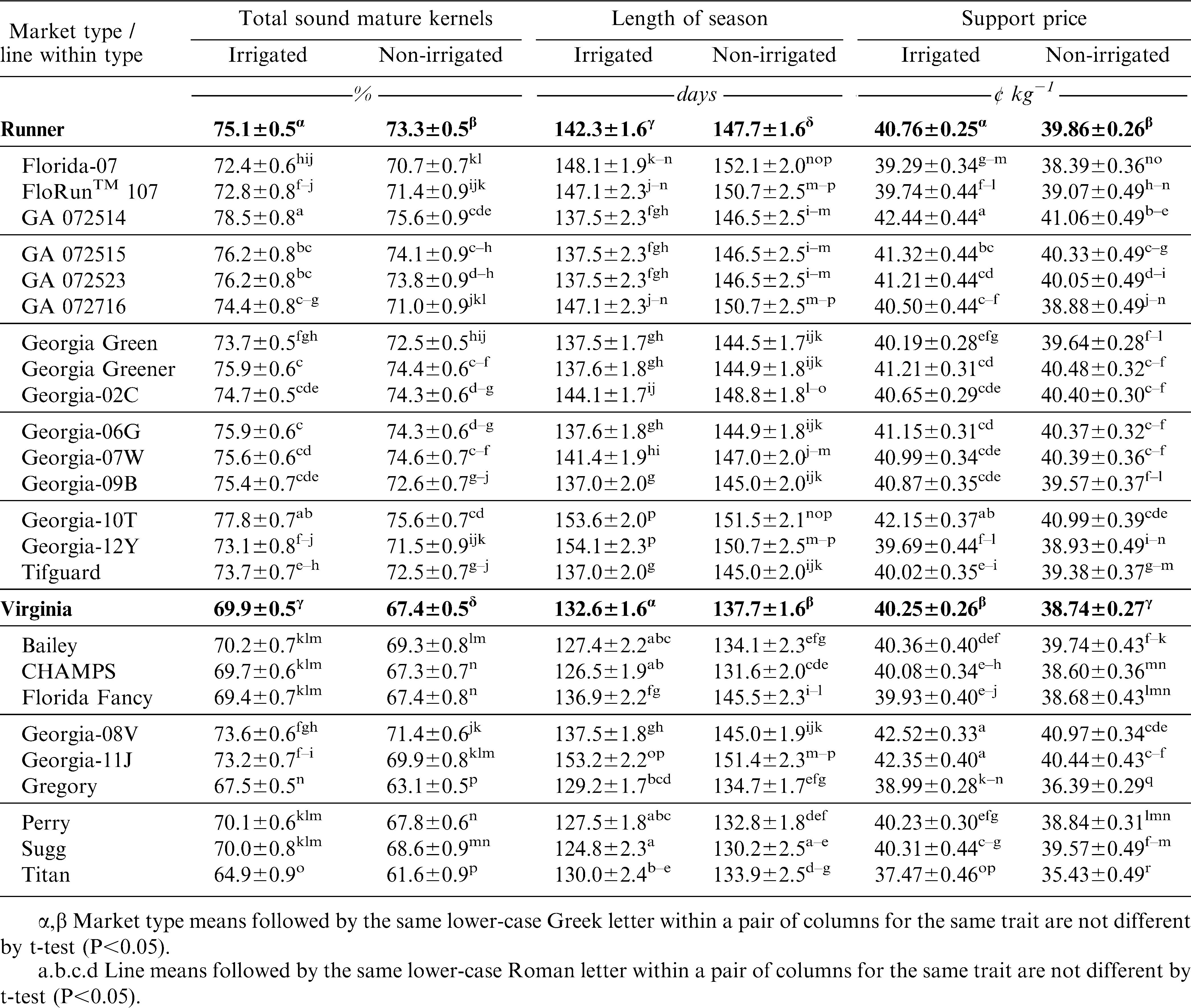Introduction
State testing programs are an integral part of evaluation of cultivars and breeding lines for genetic improvement and production in all crops including peanut (Arachis hypogaea L.). Prior to cultivar release, new breeding lines are tested sequentially in the breeder’s trials, perhaps in in-state “official variety tests” (OVTs), in regional trials like the Peanut Variety and Quality Evaluation program in the Virginia-Carolina area (Balota et al., 2013), and in national trials, the Uniform Peanut Performance Tests in the case of peanut (Branch et al., 2013). Data from these trials usually forms the breeder’s basis for making a cultivar release. Following release, the grower’s decision to purchase seed and plant a particular cultivar is largely a function of data accumulated as part of regional trials or in-state OVT results.
Because of its importance in terms of national peanut production, the state of Georgia’s OVT program is deserving of attention. Each year, seven trials are grown in the state of Georgia, an irrigated test of spanish-type (A. hypogaea subsp. fastigiata Waldron var. vulgaris Harz) and valencia-type (A. hypogaea subsp. fastigiata var. fastigiata) lines and cultivars at the Coastal Plain Exp. Stn. at Tifton, GA, and irrigated and non-irrigated trials of runner- and virginia market-type lines and cultivars at Tifton and at the Southwest and Southeast Research and Education Centers at Plains and Midville, GA, respectively. Results of these trials from 1997 through 2012 are available at www.swvt.uga.edu/pct-tests.html (confirmed 24 June 2013) and are presented for individual tests, i.e., year by year, location by location, and water regime (irrigated or non-irrigated) by water regime. No means across years, locations, or water regimes are presented. The Georgia OVT program does allow entry of advanced experimental breeding lines from publicly funded programs.
It was the objective of this research to determine the mean performance across tests for currently used runner and virginia cultivars and breeding lines under consideration for release and to determine if those cultivars and breeding lines exhibited interaction with water regimes, i.e., if some lines performed better than others when irrigated or grown under rain-fed conditions.
Materials and Methods
Means for individual runner and virginia cultivars and breeding lines from individual tests were transcribed from the on-line reports of results (www.swvt.uga.edu/pct-tests.html) into a data base for the Georgia peanut OVT program. Although irrigated and non-irrigated trials were grown at each site in all 16 years, data from a few tests were discarded. These were generally data from non-irrigated trials that did not receive adequate moisture or trials that were ruined by weather conditions following digging. There were 2,584 means recorded for pod yield, total sound mature kernels (TSMK), and weight of 100 seeds for all lines, content of other kernels (OK) for all cultivars and extra large kernels (ELK) for virginia cultivars. Seed size data were reported as number of seeds per pound but converted to grams per 100 seeds by dividing the reported number into 45,400. Support price was estimated using the 2012 USDA-AMS loan price of 0.53623¢ kg−1 %−1 TSMK for runner cultivars and 0.54692¢ kg−1 %−1 for virginia entries, the ELK premium of 0.03855¢ kg−1 %−1 for virginia entries, and the OK price of 0.15419¢ kg−1 %−1 for both types of cultivars. Dollar value ($ ha−1) was estimated as the product of yield (kg ha−1) times price (¢ kg−1) divided by 100.
Planting dates were reported for each trial as was the digging date for each line in a trial, so length of season for each test entry was computed as days between planting and digging. Tests were conducted in randomized complete block designs with six reps per trial. Soils for the three locations were Tifton loamy sand (fine-loamy, kaolinitic, thermic plinthic kandiudult) at Tifton, Greenville sandy clay loam (fine, kaolinitic, thermic rhodic kandiudult) at Plains, and Dothan sandy loam (fine-loamy, kaolinitic, thermic plinthic kandiudult) at Midville. Planting dates were the same for all lines in a given test, but lines were dug at different times depending on their maturities and how well their vegetative parts held up under the diseases present at individual locations.
A subset of 869 observations was taken from the larger set of data for purposes of statistical analysis. It included results from 88 trials conducted in all 16 years, three locations, and both water regimes but only those 24 runner and virginia lines that were tested in 2012 and had been tested for three or more years (Table 1).
Data for pod yield, TSMK, and 100-seed weight were subjected to analysis of variance using the mixed models procedure (PROC MIXED) of SAS Ver. 9.2 statistical software (SAS Inst., Cary, NC). Even though length of season was a time limit imposed on a particular entry in a particular test, length of season was also analyzed to identify any effects of irrigation, market type, line within market type, and interaction. The linear model used in the analysis of variance separated the effect of the market type (runner or virginia) from the effect of a line within a market type, both of which effects were considered to be fixed and suitable for the estimation of means rather than to be random effects whose variance should be estimated. In essence, water regimes were treated as whole plots and year as a replicating variable; the lines were grown in subplots of a sort of split plot design. Although results from some trials were discarded, it was still possible to estimate the fixed effects of market-type-by irrigation interaction and interaction of lines within market types with irrigation. The effects of macro-environments, i.e., of combinations of years and locations, were considered to be random as were the effects of irrigation-by-environment interaction. Means adjusted for the effects of years and locations were computed for water regimes, and for market types, cultivars and breeding lines across and within water regimes using the “least squares means” (LSMEANS) option of SAS PROC MIXED. Mean separation for each type of mean was performed using t-tests with α = 0.05.
Results and Discussion
As expected, the main effect of irrigation was detected for all traits: pod yield (5,129 kg ha−1 irrigated vs. 4,248 kg ha−1 non-irrigated, P<0.0001), TSMK (72.5 vs. 70.3%, P<0.0001), 100-seed weight (77.7 vs. 73.8 g, P<0.0001), length of season (137.4 vs. 142.7 days, P = 0.0010), support price (40.50 vs. 39.30¢ kg−1, P<0.0001), and dollar value (2,088 vs. $1,688 ha−1, P<0.0001). It must be recognized that in peanut, the grower decides the length of season by digging the plants, so length of season is an imposed trait, not a measured trait such as yield although yield can be affected by grower decisions as well. However, we must assume that no other cultural practice was applied differentially to different lines, and we further assume that the decision to dig was based on the grower’s estimate of the approximate maturity of the particular line. It is interesting to note that irrigation resulted in the lines being dug on average five to six days earlier than non-irrigated ones, yet they yielded 882 kg ha−1 more, had 2.1% higher TSMK, were worth 1.20¢ kg−1 and $400 ha−1 more, and had seeds that were 39 mg heavier on average. Differences between the runner and virginia market types are commonly observed; this study was no different. The runners differed from virginias for pod yield (4,922 vs. 4,455 kg ha−1, P<0.0001), TSMK (74.2 vs. 68.6 %, P<0.0001), 100-seed weight (62.1 vs. 89.3 g, P<0.0001), length of season (145.0 vs. 135.1 days, P<0.0001), support price (40.31 vs. 39.49¢ kg−1, P<0.0001), and dollar value (1,996 vs. $1,781 ha−1, P<0.0001). With the 467 kg ha−1 advantage in yield, 5.5% in TSMK, 0.82¢ kg−1 in price, and $215 ha−1 in value, it is not surprising that the vast majority of the peanuts grown in Georgia are of the runner rather than virginia market type. There were 41,345 ha of runner cultivars certified in Georgia in 2012 and 0 ha of virginia cultivars (AOSCA, 2013).
There was interaction between water regimes and lines for all reported traits except estimated dollar value (Table 2). For pod yield and 100-seed weight the interaction was solely between water regimes and market types, for TSMK and length of season it was solely between water regimes and lines within market types, and for estimated support price it was both. Again the results are not surprising, but they do document the interactions in the Georgia OVT program. In general, the effect of irrigation was more substantial on grade of virginia lines than it was on runners: 2.9 g increase in 100-seed weight for runners vs. 5.0 g for virginias (P = 0.0234), and 0.90¢ kg−1 increase in support price for runners vs. 1.51¢ kg−1 for virginias (P = 0.0009) (Table 3). The converse was true for pod yield; runners responded by 982 kg ha−1 when irrigated while virginias yielded 782 kg ha−1 more (P<0.0169). Although the interaction of water regime and market type was not significant at the 5% α-level, runners increased 1.8% in TSMK with irrigation vs. 2.4% for virginias (P = 0.0598), yet their increase in dollar value was still $434 ha−1 vs. $366 ha−1 for virginias (P = 0.0593).
The effect of line within market type was highly significant (P<0.001) for all traits (Table 4). Among the runner cultivars and breeding lines, ‘Georgia-12Y’ (Branch, 2013) had the greatest yield and dollar value, but it was late in maturity, being dug on average 11 days later than was ‘Georgia-06G’ (Branch, 2007b), the cultivar most widely grown in Georgia in 2013 (AOSCA, 2013). It remains to be seen if Georgia growers will accept later maturity in exchange for greater production. All of the currently grown cultivars had greater yield and value than did ‘Georgia Green’ (Branch, 1996), previously the most commonly grown cultivar. The TSMK content and weight of 100 seeds were lower for Georgia-12Y than for some other runner cultivars, so the southeastern area shellers as well as growers may have preferences for other particular cultivars.
Although in this study, the virginia cultivars were on average less valuable than were the runner cultivars, they still exhibited considerable variation for the traits measured. The Univ. of Georgia releases, ‘Georgia-08V’ (Branch, 2009) and ‘Georgia-11J’ (Branch, 2012), had higher yields and values than did any other virginia cultivar. Indeed these two releases were competitive in terms of value with the runner cultivars. However, they were again later in maturity. Georgia-08V was dug on average at 141 DAP and Georgia-11J at 152 DAP while the average digging of the other virginia cultivars was at 132 DAP. ‘Florida Fancy’ was as late as Georgia-08V. Compared with virginia cultivars from the Virginia-Carolina (V-C) production area, the Georgia releases were 10 to 12 days later. One cannot simply leave the other virginia-type lines to grow longer: white mold caused by Sclerotium rolfsii Sacc. and tomato spotted wilt caused by Tomato spotted wilt tospovirus (TSWV) are more severe in the southeastern area than in the V-C area: lines from outside the Southeast were not developed in an environment with heavy incidence of white mold and TSWV and might not have sufficient resistance to perform well in that environment. Disease incidence could be the reason that they were dug earlier than the Georgia virginia lines, although it was not clear that another 10–12 days of growing would make significant difference with regard to disease incidence or pod yield that late in the season.
Interaction between water regimes and specific lines within market types was detectable for TSMK, length of growing season, and support price (Table 5). In the case of TSMK, three runner lines were highly reactive to irrigation, namely cultivar ‘Georgia-09B’ (Branch, 2010) and breeding lines GA 072514 and GA 072716 while cultivar ‘Georgia-02C’ (Branch, 2003) showed the least effect of irrigation. Among the virginia cultivars, the very large-seeded cultivars ‘Gregory’ (Isleib et al., 1999) and ‘Titan’ (Balota et al., 2011) had large responses while the smaller-seeded cultivars ‘Bailey’ (Isleib et al., 2011) and ‘Sugg’ were less responsive to irrigation. The same cultivars were notable for their responses to irrigation in support price, although in this case the lines that were least responsive in TSMK were the greatest for price and vice versa. Irrigation decreased length of season for most lines although the number of days less did vary somewhat. It may be that water stress induced by lack of irrigation, especially if drought stress occurred in the middle of the season when one would expect pod initiation and early filling to occur, tended to lengthen crop maturity. However, the most recent releases from the Univ. of Georgia, Georgia-10T and Georgia-12Y in the runner market type and Georgia-11J in the virginia market type, were actually left in the field longer when irrigated than when not.
In summary, as one might expect irrigation had a positive effect on pod yield, TSMK, weight of 100 seeds, support price, and dollar value. It tended to decrease the duration of the crop in the field although a few recently released cultivars were dug later when irrigated than they were when non-irrigated. There was statistically significant (P<0.05) interaction of water regime with cultivars and breeding lines for all traits except dollar value which had a significance level of P = 0.0593 for interaction between water regime and market type. This water-regime-by-market-type interaction was common with the effect of irrigation being more pronounced in virginia lines for grade factors but more so on runner lines for pod yield and dollar value. Superior cultivars in the trials were runners Georgia-12Y and virginias Georgia-08V and Georgia-11J. There was some interaction between water regimes and specific cultivars and breeding lines, most notably for length of season.
Literature Cited
Assoc. of Official Seed Certifying Agencies . 2013 . 2012 Acres applied for certification report . AOSCA, Moline, Ill. 116 p.
Balota M Monfort W.S and Isleib T.G 2013 . 2012 Peanut Variety and Quality Evaluation results - agronomic and grade data . Va. Polytechnic Inst. and State Univ., Va. Agric. Exp. Stn., and Tidewater Agric. Res. and Ext. Ctr. Inf. Ser. No. 501, 63 p.
Balota M Mozingo R.W Coffelt T.A Isleib T.G Beahm B.R Pittman H.G Bryant F.S Copeland P.A Daughtrey C.J Kennedy B.C Shokes F.M Ashburn R.D Whitt D.L and Redd D.A 2011 . Registration of ‘Titan’ peanut . J. Plant Reg. 5 : 282 – 288 . (doi:10.3198/jpr2010.09.0531crc)
Branch W.D 1996 . Registration of ‘Georgia Green’ peanut . Crop Sci. 36 : 806 .
Branch W.D 2003 . Registration of ‘Georgia-02C’ peanut . Crop Sci. 43 : 1883 – 1884 .
Branch W.D 2007a . Registration of ‘Georgia Greener’ peanut . J. Plant Reg. 1 : 121 . (doi: 10.3198/jpr2006.12.0813crc)
Branch W.D 2007b . Registration of ‘Georgia-06G’ peanut . J. Plant Reg. 1 : 120 . (doi: 10.3198/jpr2006.12.0812crc)
Branch W.D 2009 . Registration of ‘Georgia-08V’ peanut . J. Plant Reg. 3 : 143 – 145 . (doi:10.3198/jpr2008.11.0657crc)
Branch W.D 2010 . Registration of ‘Georgia-09B’ peanut . J. Plant Reg. 4 : 175 – 178 . (doi:10.3198/jpr2009.12.0693crc)
Branch W.D 2012 . Registration of ‘Georgia-11J’ peanut . J. Plant Reg. 6 : 281 – 283 . (doi:10.3198/jpr2011.11.0604crc)
Branch W.D 2013 . Registration of ‘Georgia-12Y’ peanut . J. Plant Reg. 7 : 151 – 153 . (doi:10.3198/jpr2012.11.0048crc)
Branch W.D and Brenneman T.B 2008 . Registration of ‘Georgia-07W’ peanut . J. Plant Reg. 2 : 88 – 91 . (doi:10.3198/jpr2007.12.0682crc)
Branch W.D and Culbreath A.K 2011 . Registration of ‘Georgia-10T’ peanut . J. Plant Reg. 5 : 279 – 281 . (doi:10.3198/jpr2010.11.0635crc)
Branch W.D Balota M Isleib T.G Chapin J.W Bostick J.P Tillman B.L Burow M.D Baring M and Chamberlin K.D 2013 . Uniform Peanut Performance Tests, 2012 . Univ. Georgia Coastal Plain Exp. Stn. Prog. Rep. No. 4-13. 23 pp.
Gorbet D.W and Tillman B.L 2009 . Registration of ‘Florida-07’ peanut . J. Plant Reg. 3 : 14 – 18 . (doi:10.3198/jpr2008.05.0276crc)
Holbrook C.C Timper P Culbreath A.K and Kvien C.K 2008b . Registration of ‘Tifguard’ peanut . J. Plant Reg. 2 : 92 – 94 . (doi:10.3198/jpr2007.12.0662crc)
Isleib T.G Milla-Lewis S.R Pattee H.E Copeland S.C Zuleta M.C Shew B.B Hollowell J.E Sanders T.H Dean L.O Hendrix K.W Balota M and Chapin J.W 2011 . Registration of ‘Bailey’ peanut . J. Plant Reg. 5 : 27 – 39 . (doi:10.3198/jpr2009.12.0742crc)
Isleib T.G Rice P.W Mozingo R.W Mozingo R.W and Pattee H.E 1999 . Registration of ‘Gregory’ peanut . Crop Sci. 39 : 1526 .
Isleib T.G Rice P.W Mozingo R.W Bailey J.E Mozingo H.E and Pattee H.E 2003 . Registration of ‘Perry’ peanut . Crop Sci. 43 : 739 – 740 .
Mozingo R.W Coffelt T.A Phipps P.M and Coker D.L 2006 . Registration of ‘CHAMPS’ peanut . Crop Sci. 46 : 2711 – 2712 .
Notes
- Professor, Dept. of Crop Science, Box 7629, N.C. State Univ., Raleigh, NC 27695
- Dept. of Crop and Soil Sciences, Univ. of Georgia, Griffin Campus, 1109 Experiment St., Griffin, Georgia 30223-1797
- Dept. of Crop and Soil Sciences, Univ. of Georgia, Coastal Plain Exp. Stn., 2360 Rainwater Rd., Tifton, GA 31793-5766
- Dept. of Crop and Soil Sciences, Univ. of Georgia, Coastal Plain Exp. Stn., 104 Research Way, Tifton, GA 31793
- Dept. of Crop and Soil Sciences, Univ. of Georgia, Coastal Plain Exp. Stn., 2360 Rainwater Rd., Tifton, GA 31793-5766 * Corresponding author. E-mail tom_isleib@ncsu.edu.
Author Affiliations






